The fire burning in Prince Albert National Park has grown again, reaching an estimated size of 29,600 hectares. Named the Rabbit Creek fire, it was listed at 17,000 hectares heading into the long weekend.
A map provided by Parks Canada seems to indicate much of the fire’s growth is on its north side. The south side bordering provincial land remains mostly contained., with some spot fires emerging to the south and west.
According to Wednesday’s wildfire update, the fire is being “directly and indirectly” attacked with helicopters dropping buckets of water, water tankers, heavy equipment and firefighters.
The park said the ongoing dry and warm weather are contributing to increased fire activity and significant smoke in the area.
Park closures began Tuesday due to extreme fire danger and smoke, but not due directly to the fire’s activity. It is still burning in a portion of the park far away from most infrastructure.
Also, as a precautionary measure, the park said that facility and infrastructure protection, as well as fuel management actions, are being put into place in and around Waskesiu.
Waskesiu itself remains open, as do the Boundary Bog, Red Deer Trail Network, Waskesiu River and Fisher Trails. The Hanging Heart Lakes and Crean Lake remain open for day-use boating but will be closed overnight.
The rest of the park, including the Kingsmere area and Highway 263 south of the Narrows Road, remains closed.
The national park is advising residents of surrounding RMs to check with their municipalities for information about evacuation orders or alerts in their areas.
In total, 13 helicopters, two water tankers, five pieces of heavy equipment and 184 firefighters from Alberta, Saskatchewan, Ontario, Quebec and the Northwest Territories, as well as Parks Canada field units, are battling the blaze. The crews from Quebec and the Northwest Territories are new to the fight. Provincial firefighters from Alberta, Saskatchewan and Ontario had previously been called to the national park firefight.
The wildfire started as a prescribed burn back in early May designed to restore prairie grasslands where fire suppression had led to aspen stands encroaching on the traditional fescue grasslands. The prescribed burn would have opened up more habitat for the park’s bison herd to range. Park officials said shifting, unforecasted winds led to the fire crossing containment lines and growing to the uncontained forest fire seen today.
The bison herd, so far, has not been impacted by the fire, a spokesperson told the Herald. While they normally move into the southwest corner of the park, where the fire is currently active, this year they stayed north of Amyot Lake, north of the fire’s current footprint.
A fire ban remains in place in the park.
There may be some relief coming from the weather. Environment Canada is forecasting thunderstorms tomorrow, rain overnight with a chance of showers in the forecast for Friday. So long as lightning strikes don’t spark new fires, the rain could help crews get the fire under control.


